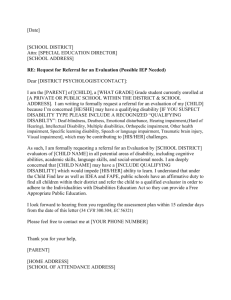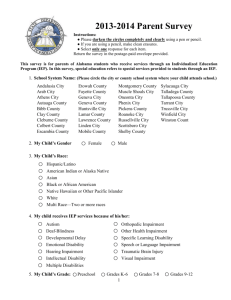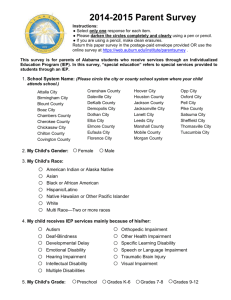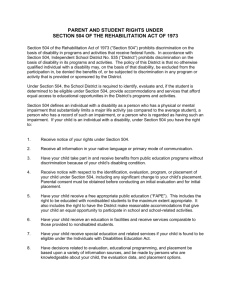Section 504: Practice Statement 6006
advertisement
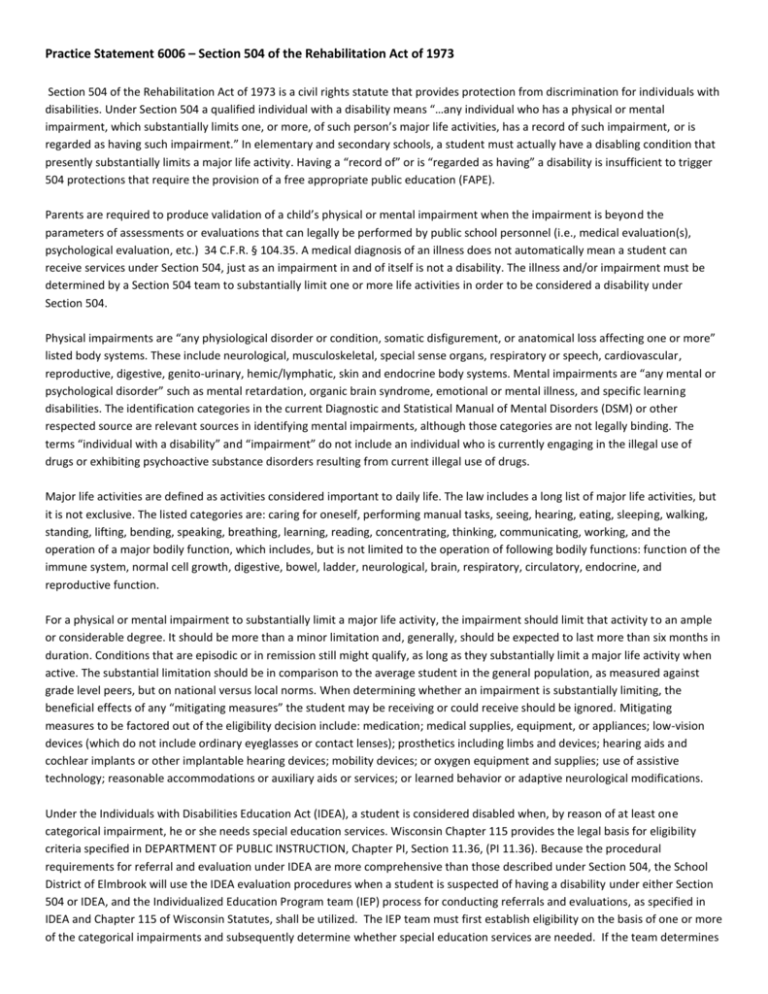
Practice Statement 6006 – Section 504 of the Rehabilitation Act of 1973 Section 504 of the Rehabilitation Act of 1973 is a civil rights statute that provides protection from discrimination for individuals with disabilities. Under Section 504 a qualified individual with a disability means “…any individual who has a physical or mental impairment, which substantially limits one, or more, of such person’s major life activities, has a record of such impairment, or is regarded as having such impairment.” In elementary and secondary schools, a student must actually have a disabling condition that presently substantially limits a major life activity. Having a “record of” or is “regarded as having” a disability is insufficient to trigger 504 protections that require the provision of a free appropriate public education (FAPE). Parents are required to produce validation of a child’s physical or mental impairment when the impairment is beyond the parameters of assessments or evaluations that can legally be performed by public school personnel (i.e., medical evaluation(s), psychological evaluation, etc.) 34 C.F.R. § 104.35. A medical diagnosis of an illness does not automatically mean a student can receive services under Section 504, just as an impairment in and of itself is not a disability. The illness and/or impairment must be determined by a Section 504 team to substantially limit one or more life activities in order to be considered a disability under Section 504. Physical impairments are “any physiological disorder or condition, somatic disfigurement, or anatomical loss affecting one or more” listed body systems. These include neurological, musculoskeletal, special sense organs, respiratory or speech, cardiovascular, reproductive, digestive, genito-urinary, hemic/lymphatic, skin and endocrine body systems. Mental impairments are “any mental or psychological disorder” such as mental retardation, organic brain syndrome, emotional or mental illness, and specific learning disabilities. The identification categories in the current Diagnostic and Statistical Manual of Mental Disorders (DSM) or other respected source are relevant sources in identifying mental impairments, although those categories are not legally binding. The terms “individual with a disability” and “impairment” do not include an individual who is currently engaging in the illegal use of drugs or exhibiting psychoactive substance disorders resulting from current illegal use of drugs. Major life activities are defined as activities considered important to daily life. The law includes a long list of major life activities, but it is not exclusive. The listed categories are: caring for oneself, performing manual tasks, seeing, hearing, eating, sleeping, walking, standing, lifting, bending, speaking, breathing, learning, reading, concentrating, thinking, communicating, working, and the operation of a major bodily function, which includes, but is not limited to the operation of following bodily functions: function of the immune system, normal cell growth, digestive, bowel, ladder, neurological, brain, respiratory, circulatory, endocrine, and reproductive function. For a physical or mental impairment to substantially limit a major life activity, the impairment should limit that activity to an ample or considerable degree. It should be more than a minor limitation and, generally, should be expected to last more than six months in duration. Conditions that are episodic or in remission still might qualify, as long as they substantially limit a major life activity when active. The substantial limitation should be in comparison to the average student in the general population, as measured against grade level peers, but on national versus local norms. When determining whether an impairment is substantially limiting, the beneficial effects of any “mitigating measures” the student may be receiving or could receive should be ignored. Mitigating measures to be factored out of the eligibility decision include: medication; medical supplies, equipment, or appliances; low-vision devices (which do not include ordinary eyeglasses or contact lenses); prosthetics including limbs and devices; hearing aids and cochlear implants or other implantable hearing devices; mobility devices; or oxygen equipment and supplies; use of assistive technology; reasonable accommodations or auxiliary aids or services; or learned behavior or adaptive neurological modifications. Under the Individuals with Disabilities Education Act (IDEA), a student is considered disabled when, by reason of at least one categorical impairment, he or she needs special education services. Wisconsin Chapter 115 provides the legal basis for eligibility criteria specified in DEPARTMENT OF PUBLIC INSTRUCTION, Chapter PI, Section 11.36, (PI 11.36). Because the procedural requirements for referral and evaluation under IDEA are more comprehensive than those described under Section 504, the School District of Elmbrook will use the IDEA evaluation procedures when a student is suspected of having a disability under either Section 504 or IDEA, and the Individualized Education Program team (IEP) process for conducting referrals and evaluations, as specified in IDEA and Chapter 115 of Wisconsin Statutes, shall be utilized. The IEP team must first establish eligibility on the basis of one or more of the categorical impairments and subsequently determine whether special education services are needed. If the team determines that special education is necessary, an IEP shall be developed and special education services offered. If the student meets eligibility criteria for one or more categorical impairments but does not require special education services, he/she is not considered to have a disability under IDEA and an IEP is not developed. It is this student who might be identified as disabled under Section 504-only. The IEP team must then determine if the student is disabled under Section 504 and, if so, whether a 504 Plan is necessary for the student to receive a free appropriate public education (FAPE). If team participants determine that a student is disabled under Section 504 (he or she has an impairment which substantially limits a major life activity) and requires a Section 504 Plan, the IEP team process concludes and, in name, becomes a Section 504 team. Section 504 regulations require that decisions be made by a group of persons, including persons knowledgeable about the student, the meaning of the evaluation data, and the placement options. For this reason, the IEP team participants who represent such a knowledge group will complete the Section 504 process and the necessary Section 504 Plan and seek permission for its implementation from the student’s parents. The District’s current practices for assignment of case managers and for delegating team responsibilities will be followed. Team decisions are made by consensus. In the absence of a consensus, the Section 504 Coordinator or designee at the meeting makes the final decision regarding eligibility and, if needed, the Plan accommodations and related aids and/or services the student needs to access school programming. A child identified as having a disability under either IDEA or Section 504 shall be reevaluated as least every three years. The reevaluation procedures required under IDEA will be used in both cases. Section 504 Plans should be reviewed and rewritten at least annually. While Section 504 regulations do not require specific personnel to participate in the review process, it is recommended that all personnel responsible for the implementation of a student’s Section 504 Plan contribute to the review process. At any meeting to review a child’s Section 504 Plans, participants can determine that the Plan is no longer required and that the student no longer is considered disabled under Section 504. This differs from the IDEA process, which requires a reevaluation to formally discontinue special education services. Section 504 does not require aids, benefits, and services to be equally effective, or produce the identical result or level of achievement for disabled and nondisabled individuals. Rather, they must afford the student with a disability equal opportunity to obtain the same result, to gain the same benefit, or to reach the same level of achievement in the most integrated setting appropriate to the student’s needs. In the event of a disagreement between the parent/guardian and the School District in regard to the identification, evaluation, procedural guidelines, or educational placement of a student under Section 504, the parent/guardian have the right to file a District complaint, request an impartial hearing, or file a complaint with the Office for Civil Rights. Complaint Process: When a parent/guardian or adult student believes the Section 504 team did not follow Section 504 procedural guidelines in the evaluation process, he/she may: Contact the school administrator or designee with the complaint. The school administrator may pursue an informal resolution of the complaint with the agreement of the parties involved. Complete the Section 504 Complaint Form and present it to the school administrator or designee for review. With a resolution due within 10 school attendance days, the school administrator or designee will interview the complainant. A resolution shall be made in writing to the complainant. If the complainant is dissatisfied with the resolution, an appeal may be made in writing to the Superintendent/designee within 10 school attendance days after receiving notice of the resolution. With a resolution due within 10 school attendance days, the Superintendent or designee will review the complaint and resolution and may conduct further investigation if deemed appropriate. The Superintendent’s or designee’s decision shall be made in writing to the complainant. Impartial Hearing: In the event of a disagreement between the parent/guardian or adult student and the School District in regard to the identification, evaluation, procedural guidelines, or educational placement of a student under Section 504, he/she may request a hearing conducted by an impartial hearing officer from outside the School District. Parent/guardian may contact the District Section 504 Coordinator to obtain an impartial hearing officer, and have thirty (30) calendar days from the date of the challenged decision to make this request. The District will choose an impartial hearing officer and will work with the parent/guardian to schedule a hearing date. The parent and student may take part in the hearing and have an attorney represent them at their own cost. Office for Civil Rights Complaint Process: A parent/guardian, student or others also may file a complaint with the federal Office for Civil Rights alleging any violations of Section 504 and/or the ADA. To make an inquiry or file a complaint under Section 504, an individual may contact: Office for Civil Rights: U.S. Dept. of Education, Office for Civil Rights, 500 W. Madison Street, Suite 1475, Chicago, IL 60661, (312) 730-1560. The School District designates the following employee to coordinate its efforts to comply with Section 504 of the Rehabilitation Act of 1973 as amended: Dr. Rae McClain, School Psychologist, (262) 781-5280; (262) 785-3930

